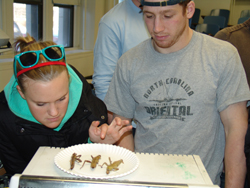
Edible insects! Students taste creepy crawly delicacies

If you really are what you eat, Botany Professor Manuel Lizarralde is an insect. The tasty kind - lightly fried with a just a touch of macadamia oil.
Lizarralde, who teaches a seminar on the indigenous use of tropical rainforests, recently invited David Gracer - an English professor at the Community College of Rhode Island and president of Small Stock Food Strategy, a company he created to promote the use of insects as a part of a healthy, sustainable diet - to visit the seminar at Connecticut College and introduce his students to the world of edible insects.
"I'm really the kind that will try anything," said Lizarralde, who once accidentally ate a live palm grub, thinking it was being offered to him as food. He'd tried them before, Lizarralde said, and when a friend showed him the grubs he'd collected on a recent trip, Lizarralde misinterpreted the gesture as an invitation to snack.
"This guy was very angry when he found his pets were gone," said Lizarralde.
As Gracer prepped the classroom cooking area, students craned their necks to sneak a peek at their afternoon snack - $150 worth of leggy, winged and grubby insects. A larvae-filled peanut jar sat cousin to a bottle of dessert wine.
"Who knows?" said Lauren Wise '10, waiting anxiously for the feast to begin. "Maybe it will taste good. I think it would help if is covered in chocolate or something."
Lizarralde explained that Gracer's argument for eating insects is all about sustainability. Insects, what he calls "the shrimp of the land," he explained, are the least used resources in the world although they are the most ecologically friendly food.
Click here to view a slideshow from the class. Click here to view a video of the class on YouTube.
"They can feed the world with minimal impact," Gracer said. "Why dust our fields with pesticides if the bugs they kill are more nutritious than the crops they eat?"
Holding up at book called "Man Eating Bugs," Gracer explained that Desert Locusts - a leggy creature considered to be an invasive species - offer vitamins, minerals and amino acids.
"The food group that could do us the most good, also is the food group that is the most condemned in those parts of the world that have the most cultural influence," he said.
Scorpians are popular in Japan, filleted giant waterbugs in Thailand and Vietnam and termites in Africa. Gracer said he particularly enjoys jumiles or stink bugs, from Mexico, rich in iodine and bitter and herby like a combination of kale and cilantro.
"If Americans eat shrimp and lobster, why don't they eat their terrestrial cousins?" asked Gracer, who described himself as a "finicky eater" as a child.
While last summer, Gracer lived on a 75 percent insect diet for 30 days, generally, he said, insects are simply incorporated into his usual meals.
"I maintain a diet much like most of you," he said. "Except for the insect part."
Lizarralde was the first to try an insect - swallowing down a house cricket. Some students grinned, while others squirmed, making what Gracer calls the "ew" face.
Megan Rousseau '09 was one of a majority of students who agreed to try an array of insects: katydids from Uganda, described as "buttery," cockroaches, fly pupae, "spicy" Mexican grasshoppers, cicadas and, of course, the giant water bug, filleted into dark and light meat with a taste "like a pear."
"It's about sustainability," Rousseau said. "And being able to live off the land."
-Julie Wernau
March 18, 2009
